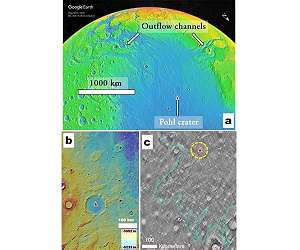This beautifully crisp icy scene with a swirling ribbon of rusty red and white striped terrain connecting two large craters wraps up the year on Mars. The High Resolution Stereo Imaging camera on board ESA’s Mars Express captured this frosty scene in the Ultimi Scopuli region near the south pole of Mars on 19 May 2022. While it may look like a winter wonderland, it was southern hemisphere spring at the time and ice was starting to retreat. Dark dunes are peeking through the frost and elevated terrain appears ice-free.
Two large impact craters draw the eye, their interiors striped with alternating layers of water-ice and fine sediments. These ‘polar layered deposits’ are also exposed in exquisite detail in the rusty red ridge that connects the two craters.
Frosty dunes
All over the image, dark dunes and dune fields can be found, in some areas covered by a thin frost layer. The dune fields take on a ‘yardang’-like shape, creating sharp ridges running parallel to the prevalent wind direction, guided by the morphology of the underlying surface. The dark dust is thought to originate from ancient, buried layers of volcanically erupted material. It can be found all over Mars and is easily spread by strong winds.
Carbon dioxide jets
Individual dark spots hint at a process specific to polar areas on Mars. Jets of carbon dioxide generated by the sublimation of ice into gas have burst through ice layers, ejecting a geyser-like fountain of dark dust that settles into these circular splotches. Monitoring these zones from orbit shows the processes that steadily alter the appearance of the surface in the polar regions on Mars.
Ice scoop
All over the image numerous large irregular-shaped sublimation features can be found arising from thawing pockets of ice. They have the appearance of (albeit empty) terrestrial lakes that have been scooped out of the landscape. A very pronounced example can be seen at the upper left image border of the main colour image.
Clouds
Hazy clouds – especially in the central part of the image – complete the atmospheric feel of the scene. Clouds in the south polar region often contain water ice and their trajectory is partly influenced by the topography of the terrain.
During the seasonal cycle, carbon dioxide ice is deposited at the poles in winter, which sublimates in the springtime. Between 12 to 16% of the planet’s atmosphere is deposited in the poles during winter, with the release of gas the following spring boosting the atmospheric pressure and generating strong winds. This ongoing process creates a huge exchange of material between surface and atmosphere throughout the martian year.
Happy New Year, Mars!
The new Mars year (Year 37 according to the way Mars years are counted) begins on 26 December this year, just one day after the 19th anniversary of Mars Express’ arrival at Mars – a double celebration for Mars fans this festive season!
Exploring Mars
Mars Express has been orbiting the Red Planet since 2003, imaging Mars’ surface, mapping its minerals, identifying the composition and circulation of its tenuous atmosphere, probing beneath its crust, and exploring how various phenomena interact in the martian environment.
Related Links
Mars Express at ESA
Mars News and Information at MarsDaily.com
Lunar Dreams and more
|
We need your help. The SpaceDaily news network continues to grow but revenues have never been harder to maintain. With the rise of Ad Blockers, and Facebook – our traditional revenue sources via quality network advertising continues to decline. And unlike so many other news sites, we don’t have a paywall – with those annoying usernames and passwords. Our news coverage takes time and effort to publish 365 days a year. If you find our news sites informative and useful then please consider becoming a regular supporter or for now make a one off contribution. |
||
|
SpaceDaily Contributor $5 Billed Once credit card or paypal |
SpaceDaily Monthly Supporter $5 Billed Monthly paypal only |
|

![]()
NASA May Have Landed on a Martian Megatsunami Deposit Nearly 50 Years Ago
Tucson AZ (SPX) Dec 02, 2022
When NASA’s Viking 1 lander touched down on the surface of Mars nearly 50 years ago, its cameras imaged a boulder-strewn surface of elusive origin. New research led by Planetary Science Institute Senior Scientist Alexis Rodriguez shows the landing site may be on the margins of a megatsunami deposit, formed when a 3-kilometer asteroid impacted a northern Martian ocean about 3.4 billion years ago.
“The lander was designed to seek evidence of extant life on the Martian surface, so to select a suitabl … read more